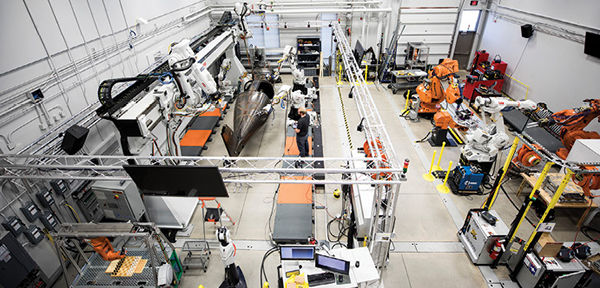Competition’s UAV Focus Connects U.S. Army With Next-Gen Talent
Student Design Competition Profile: The FirePoint C3 Challenge

The final teams in the competition work directly with the U.S. Army and industry partners to assist in UAV development. Image courtesy of FirePoint.
Latest News
November 1, 2019
FirePoint Innovations is a Center of Wichita State University that is also a partnership intermediary for the U.S. Army’s Combat Capabilities and Development Command (CCDC) Aviation and Missile Center.
Stephen Cyrus is the manager of Technology Collaborations for FirePoint. FirePoint helps advise students and manage the center’s C3 competition. We spoke to him to learn more about the competition.
Digital Engineering: Can you provide an overview of your competition, how it came to be and the intent of the program? Who will be participating or who has participated?
Stephen Cyrus: FirePoint and CCDC Aviation and Missile Center believe that the future of manufacturing will not look the same as it does today. Many companies are already adopting new methods to increase efficiency and quality of their end products. This competition looks to expose the bright minds of tomorrow, leveraging their ideas early in their careers, so that we can assist in developing the next-generation workforce.
Teams submit a concept proposal in a specific unmanned aerial vehicle (UAV) subsystem. Proof of concepts are evaluated against competition criteria. The top three teams are chosen to converge their subsystem prototypes. Teams collaborate with each other to finalize development with the help of the Army and industry. Teams work and network with executives at partner companies. They then showcase the final product to the U.S. Department of Defense.
Participants include university-based teams with a faculty advisor. Each team will consist of full- and part-time undergraduate and graduate students attending a specific university. Each member must be 18 or older at the time of the proposal request date and must be a U.S. citizen or green card holder. A team may have one faculty advisor who acts as a facilitator for team activities.
The minimal number of team members required is one student and one faculty advisor. The maximum number of student team members is 15. Teams may add or remove team members at any point in the competition. We’d like to see at least 25 teams submit white papers to participate in the competition.
DE: Can you provide some examples of what the event has produced or what you expect it to produce?
Cyrus: We can expect this competition to produce the most advanced technologies in the UAV space that exist today from the next generation of designers, thinkers and innovators. Some innovations that we expect seeing include, hybrid energy propulsion systems, embedded electronics, Internet of Things implementation and energy harvesting techniques.
DE: Does your organization, or the consortium of organizers of this competition, have a particular stance on adopting an innovation that is linked to the program? What drives firms to sponsor the event and coordinate it?
Cyrus: The final teams work directly with the U.S. Army and industry partners to assist in development. The U.S. Army is looking forward to and prepared to adopt UAV technology from this competition that they see fit.
The partner organizations will be introduced to some of the top engineering minds about to enter the workforce, giving them an opportunity to onboard students after graduation.
DE: Is there anything else you’d like to tell us about the event that the above questions haven’t given you the opportunity to express?
Cyrus: After the first down selections, teams will each receive up to $10K in funding to produce a proof of concept. After the second down selections, teams each receive an additional round of up to $25K in funding for a total of $35K.
We believe that the C3 Challenge will take concepts out of the lab and combine them to create superior technology. It not only brings university teams together to collaborate, but provides the opportunity to work with the U.S. Army and create a future with some of the world's most advanced companies.
Subscribe to our FREE magazine, FREE email newsletters or both!
Latest News
About the Author
Jim Romeo is a freelance writer based in Chesapeake, VA. Send e-mail about this article to [email protected].
Follow DE





